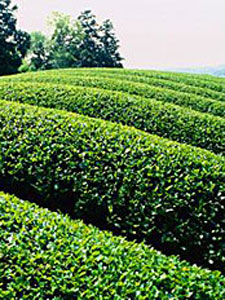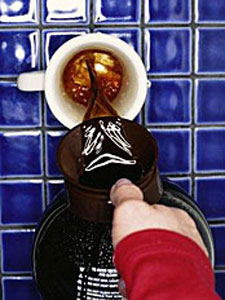A Different Aesthetic, or, Four Weeks With Tea



The thing that hits you, the first thing you notice, your first impression when you enter the Adagio warehouse is the scent.
I'm going to do an inadequate job of describing it. It is every single tea, all—what's the official count? 150?—hitting you at the exact same moment. It is a smell of fruit, of spice, of chocolate. If you concentrate hard enough, you can almost pick out the individual parts of it. Here, that's jasmine. Here, that's orange. Here, that's vanilla. Here, that's sencha.
When you walk into the warehouse and you smell every single tea at once—and it's always a slightly different mix, depending on what tea is being flavored that day, there's always one note that's slightly stronger, today it could be strawberry, tomorrow it could be caramel—there's an immediate need, an immediate compulsion, to want to try every single one at once. Now. No time to brew it.
I've been a tea drinker since I was small but I've never been a connoisseur. It's something I drink when I'm sick because it soothes the throat. I'll buy boxes of it—always in teabags—and not really pay attention to how hot I've made the water or for how long I steep it for.
It's overwhelming being suddenly thrust into the position of being an expert on something you thought you knew. It's difficult. My field is videogames: I've been writing about them since I was 19. I can pound out an article on gaming in no time flat. I can name you almost every important game that came out in the past 20 years, and I can give you an honest review of all of them. I can name you the major figures in gaming. I can show you my library; it's a true connoisseur's.
If you'd asked me, a month or two ago, to name my favorite teas, I'd probably point vaguely to a couple of boxes of teabags that I'd picked up at the supermarket at some point.
Sitting in the warehouse, looking at the dozens of varieties of teas, some of which I had no idea even existed, I realize that I've got a lot to learn.
"All tea, except for rooibos and herbals, is made from the same plant. It's called camellia sinensis. What you get—whether it's a black tea, oolong, green, or white, depends on how it's processed. Every single one comes from the same place." I've said that I don't know how many times in the past few weeks and I still only vaguely believe it. I can open a ti kuan yin, an English breakfast, a jasmine pearl, a silver needle, a darjeeling, and they'll all look completely different. They'll smell different and they'll all taste different. And yet they're all from the same base. I still don't get it.
I mean I understand herbal teas and why they all have distinct tastes, smells, colors. I understand flavored teas. But I don't know why a white tea is practically a different animal from a black.
When I started working at Adagio, everyone—from coworkers to people on the chatboards to friends—insisted that I try my best to taste every single tea. And it's been a challenge I've tried to match. Pu erh—have you had it? It's hardcore. It's fermented tea. It smells of the earth. It's dark. It's one of the strongest things I've ever drank. Or genmai cha, which is green tea mixed with toasted rice and popcorn, with a very nutty flavor. I wouldn't have touched them at one point, but I'm taking my mission seriously.
I've tried white tea again and again, trying to find the flavor and at last recognizing it. I've figured out how to brew oolongs properly. I know why you don't overbrew black teas, why you can't leave them in and just sip them during the course of a long class. I'm learning about antioxidants and tannins and the history of tea and all of that.
What I'm saying is that the World of Tea, as I see it, is a lot more complex than I ever though it could be.
I once found myself in a coffee-drinking match with a guy from Seattle. We were in a local diner with some friends one night, sometime during my junior year of college. It was late—around 2 in the morning—and we all had papers to write that we were avoiding. And I don't even remember how we got on the subject, but we began arguing about who liked coffee more. And so we decided, because late-night competitions are always a good idea, to match each other cup-for-cup. We knew the waitress well because we went to this diner practically nightly at this point, and she kept a full carafe at our table. After the sixth cup we were wired and I remember that neither of us got much sleep that night. We ended up arguing over who truly drank more coffee, since I put cream and sugar in mine while he drank his black. Ultimately we called it a truce and split a plate of fries. The point is I used to be a hardcore coffee drinker. I spent every night in diners drinking bad coffee; I'd go to Starbucks before classes and load up on redeyes; I'd make a pot of coffee in the mornings before work and bring a thermos for the ride in. I was never a gourmet; I just wanted the caffeine. Certainly I like the taste of coffee, but it's never been an aesthetic experience. I've been working at Adagio for about a month and I can probably count on one hand the number of cups of coffee I've drank since I started. The experience of tea seems so much richer, so much more elegant, so much more varied. And, I mean, I know there are certainly enough people around who will argue the opposite point. But I'm discovering such a rich tea culture around me. Coffee—for myself as well as for most everyone I know—is just something that you drink, and if it happens to taste good, well, that's great. Having dozens of varieties of tea, each adding its scent to the overall impression, each with their own special note to offer, kind of implies to me that there's a bigger purpose to this tea business than I originally thought. I'm not merely in the business of providing someone with their next caffeine rush, as I'd be if I were to sell coffee (and I'm sure I have a lot to learn about coffee as well, incidentally.) In a big way I'm excited to learn more because it's clear that every tea has got a different aesthetic to offer.
